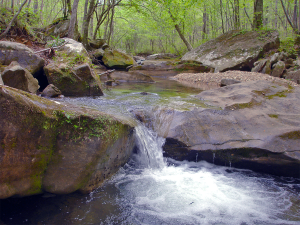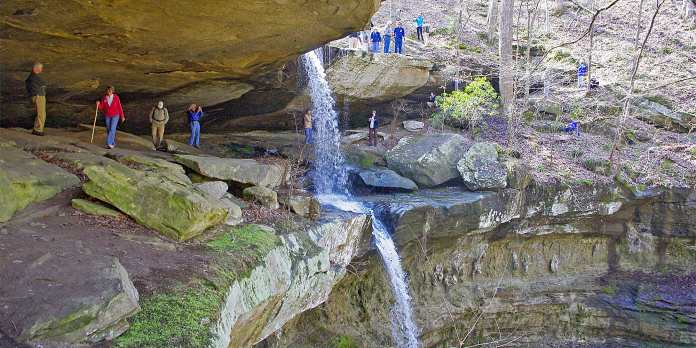TUSCUMBIA — Nature lovers are blessed with abundant recreational and travel opportunities the Alabama Department of Conservation and Natural Resources offers in north Alabama, like Joe Wheeler State Park, Monte Sano State Park and several wildlife management areas.
But the possibilities don’t end there.
For those who love to explore new territory, I’ve got a perfect place to get in a robust hike and learn a great deal about Alabama’s natural history and how Alabama’s beaches were once located in the upper reaches of the state.
Cane Creek Canyon Nature Preserve just a few miles south of Tuscumbia may not be on the hiking crowd’s radar, but it provides a unique look at one of the state’s most diverse habitats.

Jim and Faye Lacefield bought 40 acres in Colbert County about 45 years ago and turned it into a passion project that ballooned to more than 700 acres that included Cane Creek Canyon.
“We bought the back 40 of a property that was being divided,” said Jim, an award-winning educator in biology and earth science who taught the last 10 years of his career at the University of North Alabama. “That was all we had for a while, and then we added, little by little, land that nobody else really wanted. It was down in the canyon, and you couldn’t get to it very easily.
“We got the idea very early on that it would be a great place for a nature preserve because it was fairly unspoiled.”
One factor that contributed to the Lacefields’ land acquisition goals was the end of the prohibition of alcohol sales in Colbert County.
“When we came, it was right at the end of the big-time bootlegging days,” Jim said. “Every little hollow had a still or two. When the county went wet, it drove the bootleggers out of business, and we were able to buy some more land that wasn’t any good for anything except for bootlegging.
“It was hidden and hard to get to, but it had some things we really liked about it. The biodiversity was really high with lots of rare plants and lots of wildlife and fairly restricted access. We didn’t have any trouble with folks coming in and leaving trash or starting fires or anything.”
The Lacefields eventually acquired 713 acres that was groomed for public access to 15 miles of hiking trails that are rated as moderate in the hiking world because of the elevation change of about 350 feet from the canyon rim to the bottom. I have one suggestion after making the 3.25-mile trek to the overlook – have quality hiking shoes or boots that you lace tightly for the descent into the canyon. A visitor support station is at the entrance to the preserve with maps and loaner hiking sticks, which I highly recommend.
“We have some guided hikes we recommend,” Jim said. “One is a 3 1/4-mile hike that goes down into the canyon, past the waterfalls to the scenic overlook at the point. People who have a half-a-day can take the longer hike that ends up being about 7.5 miles, roundtrip. In all, we have about 25 miles of trails. There are about 12 good-size waterfalls on the preserve. The largest one is a 60-footer that is on the way into the preserve. Almost everybody sees it, but it’s just the first of many. There are several side canyons that come together, and every one of those has a waterfall at the head of it.”
When I visited, the area hadn’t had any rainfall in three months, so the waterfalls were down to trickles.
“But it flows well for most of the spring and winter,” Jim said. “Those are our peak flow times. The preserve is good to visit during every season. When the rains start in late November until the first of May is when the waterflow is best. Then you start getting that evapotranspiration in the woods that sucks the water out of the ground.”
Faye, also a retired educator, added that many of the visitors to the preserve come from the Midwest where they have some of the same geological features as the preserve.
“One reason we have a particularly biodiverse area is that we’re right at the overlap area for a variety of physiographic provinces and landscape regions of Alabama,” Jim said. “We’ve got a little bit of everything mixed in here. We’ve got the coastal plain. All the ridgetops around here have this rounded gravel, and that defines the coastal plain area. This was the edge of the Gulf of Mexico back during dinosaur times.
“The canyon wall is part of the interior low plateau. We’re on the southern edge of the time the continents were coming back to form Pangaea, when all the continents came together for a period of time and then separated again. All of the (Hartselle) sandstone in the bluffs was from the barrier island beaches.”
After his retirement from UNA, Jim worked on a revised and expanded edition of a book dealing with the history of Alabama’s geology. In 2013, his “Lost World of Alabama Rocks, A Guide to the State’s Ancient Life and Landscapes” was published.
“It deals with the history of the land in Alabama through time,” Jim said.
The Lacefields’ children live on the opposite side of the country. Their son is in New York at Columbia University researching nerve cell regeneration, and their daughter, who has degrees in archaeology and anthropology, lives in Redwood City, Calif., where she specializes in graphic art.
“Our two children were unlikely to step into what we were doing, and about two years ago I was diagnosed with Parkinson’s Disease,” Jim said. “I knew I had only a short time to do what I was doing to keep the preserve open. There’s a lot of work involved in keeping the trails open, removing trees that had fallen and repairing bridges after floods. We went looking for conservation organizations to take it over.”
The Land Trust of North Alabama ended up as the best option to take over the preserve. The Lacefields kept 20 acres where their house overlooks the entrance to the preserve.
“It was a big step for them to expand 75-80 miles out in this direction,” Jim said. “We worked out an agreement and passed the land to them. We took over the task of helping people getting started on the preserve. They took our maps and got a company to produce new trail maps. Before the Land Trust took over, we were getting 15,000-16,000 visitors a year, so there were a lot of people using it. We got written up in a lot of magazines.
“It was one of our life projects to get it more accessible to people. It wasn’t just for the hardcore hikers. A lot of people bring families. Anybody who is halfway in physical condition is able to go on a hike.”
For more information, visit https://landtrustnal.org/
The folks at Colbert County Tourism can also guide you to the other great features in northwest Alabama, including Helen Keller’s birthplace, and the famous studios that produced the iconic Muscle Shoals music at FAME Recording Studios, Muscle Shoals Sound and Cypress Moon Studios.
Don’t miss out! Subscribe to our email newsletter to have all our smart stories delivered to your inbox.



